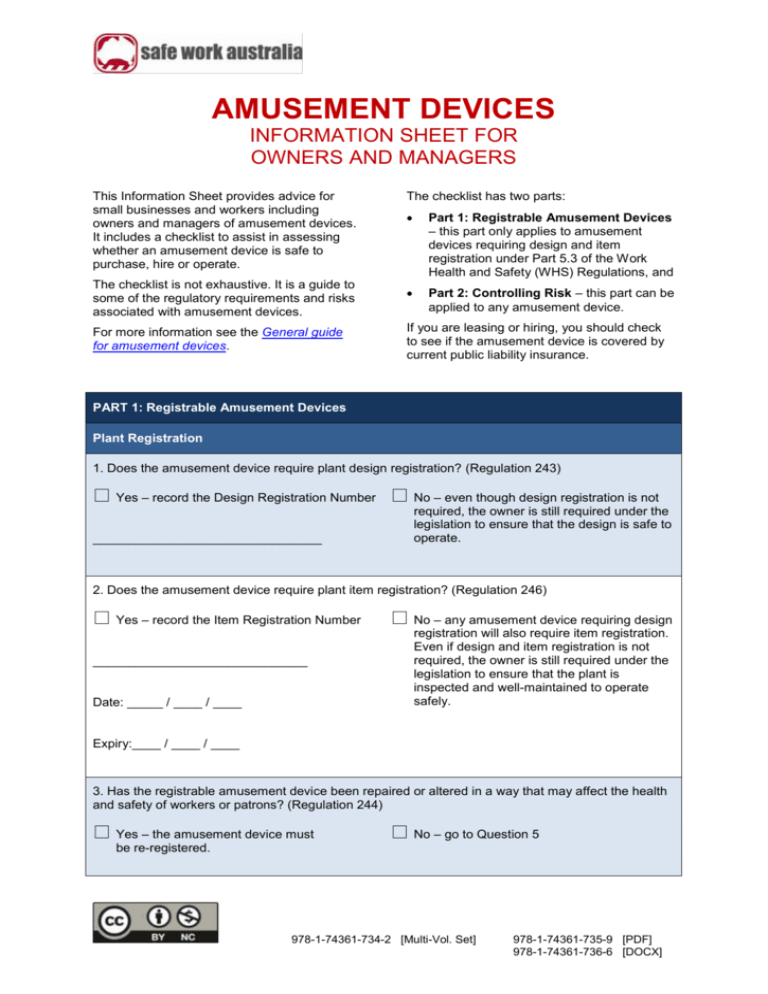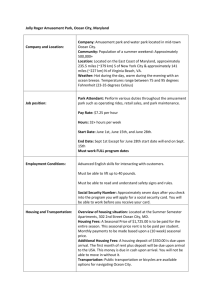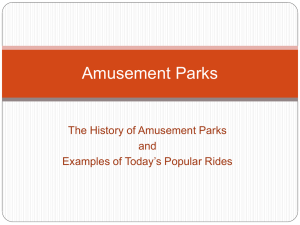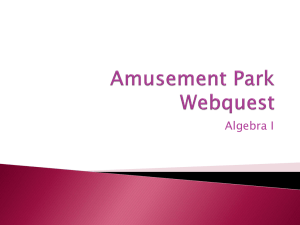0.6 Amusement devices: Information sheet for owners and managers
advertisement

AMUSEMENT DEVICES INFORMATION SHEET FOR OWNERS AND MANAGERS This Information Sheet provides advice for small businesses and workers including owners and managers of amusement devices. It includes a checklist to assist in assessing whether an amusement device is safe to purchase, hire or operate. The checklist has two parts: Part 1: Registrable Amusement Devices – this part only applies to amusement devices requiring design and item registration under Part 5.3 of the Work Health and Safety (WHS) Regulations, and The checklist is not exhaustive. It is a guide to some of the regulatory requirements and risks associated with amusement devices. Part 2: Controlling Risk – this part can be applied to any amusement device. For more information see the General guide for amusement devices. If you are leasing or hiring, you should check to see if the amusement device is covered by current public liability insurance. PART 1: Registrable Amusement Devices Plant Registration 1. Does the amusement device require plant design registration? (Regulation 243) Yes – record the Design Registration Number No – even though design registration is not ________________________________ required, the owner is still required under the legislation to ensure that the design is safe to operate. 2. Does the amusement device require plant item registration? (Regulation 246) Yes – record the Item Registration Number ______________________________ Date: _____ / ____ / ____ No – any amusement device requiring design registration will also require item registration. Even if design and item registration is not required, the owner is still required under the legislation to ensure that the plant is inspected and well-maintained to operate safely. Expiry:____ / ____ / ____ 3. Has the registrable amusement device been repaired or altered in a way that may affect the health and safety of workers or patrons? (Regulation 244) Yes – the amusement device must No – go to Question 5 be re-registered. 978-1-74361-734-2 [Multi-Vol. Set] 978-1-74361-735-9 [PDF] 978-1-74361-736-6 [DOCX] 4. If yes to Question 3, has a competent person, for example an engineer, verified the repair or alteration? (Regulation 251) Yes No – plant designs must be verified by a competent person before they can be registered. Log Book, Maintenance and Inspections 5. Does the registrable amusement device have a current log book? (Regulation 242) Yes – check the log book includes all of the elements listed in the Record keeping section of the accompanying General guide for amusement devices. No – a log book must be provided and kept for a registrable amusement device. 6. Is the log-book up-to-date including records of daily checks, maintenance and inspections? Yes – maintenance, inspection and testing must be carried out by a competent person (Regulation 240). No – update the log book. Records of maintenance, inspection and testing must be kept and made available. (Regulation 237). 7. What is the date of the last annual inspection recorded in the logbook? (Regulation 241) Date: ____ / ____ / ____ Within the last 12 months. Over 12 months ago – you must arrange for an annual inspection to be carried out before using the amusement device. PART 2: Controlling Risk 8. Is an amusement device to be installed, assembled, constructed, commissioned, decommissioned or dismantled? (Regulation 204) Yes – regulatory obligations may exist including using a competent person and minimising risks to health and safety (see Regulation 204). No – the item is not an amusement device (or related plant). Parts 5.2 and 5.3 of the WHS Regulations do not apply. Setting up the amusement device 9. Are you a supplier of an amusement device? (Regulations 198 and 199) Yes – regulatory obligations may exist. You No should review your general and plant related supplier obligations under the WHS Regulations. Amusement devices: Information sheet for owners and managers July 2014 Page 2 of 5 10. Are safe operating procedures available and do they include instructions to set-up and dismantle mobile amusement devices? (Regulations 198(b)) Yes No – check the log book for information, if not available ask the supplier for relevant safety information. 11. Have hazards been identified and risk control measures implemented so the amusement device can be safely set-up and operated, for example emergency planning, overhead electric lines, overhanging trees, sloping ground and drainage? (Regulations 34, 35 and 36) Yes No – you must identify hazards and implement risk controls. 12. Are risk control measures maintained so they remain effective? (Regulation 37) Yes No – you must review and revise risk control measures so they are effective (see Regulation 38). 13. So far as is reasonably practicable, have you made sure no amusement device, person, plant or thing comes within an unsafe distance of an overhead or underground electric line? (Regulation 166) Yes No – you should check the area for electric lines and consider how to control associated risks. 14. Has a competent person, for example a licensed electrician, checked the electrical safety (where applicable) after the amusement device has been set-up? (Regulation 150) Yes Not Applicable No - you must ensure a competent person checks the electrical components. Note: Motors, electrical leads, generators and residual current devices (RCD) must be tested and tagged in accordance with regulatory requirements. 15. Are display, festoon lighting or any other electrical cabling or connections required? (Regulation 150) Yes – extension leads and cables used to No feed the amusement device within the amusement device and plug-in electrical equipment should be tested. Cables should be secured and located to avoid tripping hazards and damage. 16. Have you prepared and maintained an emergency plan for the workplace? (Regulation 74) Yes No – you must prepare an emergency plan. Amusement devices: Information sheet for owners and managers July 2014 Page 3 of 5 17. Are suitable amusement device entry and exit points provided to evacuate the amusement device in an emergency and can emergency vehicles and equipment access the amusement device? (Regulation 74) Yes No – review the emergency plan including local emergency response requirements and amusement device set-up. 18. Is there internal lighting and are illuminated exit signs needed for the amusement device, for example where they are enclosed amusement devices or are operated in enclosed areas? Note: For ghost trains and other amusement devices requiring darkness during operation, the exit signs should illuminate if power is switched off or fails. Yes – check the internal lighting and No emergency signs are lit 19. Does the amusement device have fire extinguishing equipment and has any equipment provided been inspected? Yes – check the fire extinguishing equipment No – reassess fire risk and if present provide has a current inspection tag attached. fire extinguishing equipment. 20. Are barriers required to control access to the amusement device? (Regulations 189 and 208) Yes No - confirm no barriers are required and if so go to Question 22. 21. Could a patron or member of the public reach over, around or through the barrier and contact moving parts of the amusement device or patrons using the amusement device? Can patrons using a moving amusement device come in contact with moving parts, barriers or members of the public? (Regulation 208) Yes - review the risk control measures and No implement controls. 22. If the device has patron restraints, are they operable, maintained and effective? (Regulation 238) Yes No – do not operate the amusement device and prevent access until the restraints are repaired. Operating the device 23. Are operators trained to use the amusement device safely? (Regulation 238) Yes No – check what information, training and instruction is required to operate the amusement device safely. Ensure this information, training and instruction is provided. Amusement devices: Information sheet for owners and managers July 2014 Page 4 of 5 24. Where applicable, are amusement device loading and patron seating requirements clear and implemented? Yes Not Applicable No – check there is appropriate signage and that operators manage correct loading and seating of patrons. Do not operate the amusement device if requirements have not been met. 25. Is the amusement device, or accompanying music, loud enough to create a risk of hearing loss for workers, patrons or other people? For example, is it necessary to raise your voice to almost shouting to talk to someone 1 metre away? (Regulation 57) Yes – noise monitoring may be needed for No the amusement device and any accompanying sound system. Noise controls may also be required. 26. When not in use, is the amusement device stored so it is without risk to health and safety? (Regulation 239) Yes – the person who stores the amusement No – check a competent person will store the device must be a competent person or under the supervision of a competent person. amusement device. For further information see the Safe Work Australia website (www.swa.gov.au). Amusement devices: Information sheet for owners and managers July 2014 Page 5 of 5





